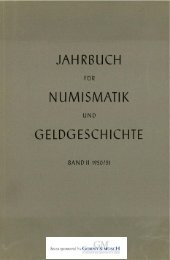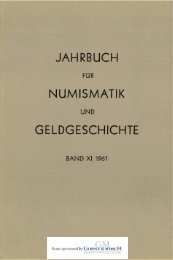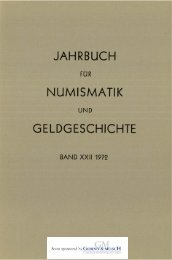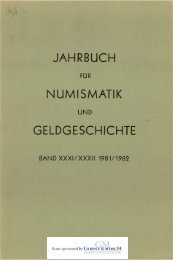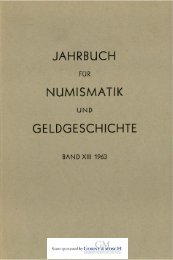jahrbuch numismatik geldgeschichte - Bayerische Numismatische ...
jahrbuch numismatik geldgeschichte - Bayerische Numismatische ...
jahrbuch numismatik geldgeschichte - Bayerische Numismatische ...
Sie wollen auch ein ePaper? Erhöhen Sie die Reichweite Ihrer Titel.
YUMPU macht aus Druck-PDFs automatisch weboptimierte ePaper, die Google liebt.
Jahrbuch f. Numismatik u. Geldgeschichte 37/38, 1987/88 11J. ELAYI, A.G. ELAYI(Paris, CNRS, Universite de Paris XIII)Systems of Abbreviations Used by Byblos, Tyre and Arwadin their Pre-Alexandrine Coinages(Pl. 3-4, 3 Tables)Phoenician pre-alexandrine coinages are still not well known and thesystems used for abbreviations and numbers have never been studied as awholet. Our purpose here is to classify these abbreviations and numbers, andto present some elements of interpretation based on the numismatic analysisand historical context2. Even if at first these abbreviations and numbers seemto present random characteristics, it is logical to assume that they follow certainrules. By systematically analysing all available data, we shall try to findsome of these rules unknown to us, but obvious to the minting authorities.We notice first that the complete or abbreviated inscription was notnecessary to identify the minting city since all the coins were uninscribed atthe beginning. It was added to the symbols represented on the coins and contributedto authenticate them. It was intended for people reading the Phoenicianlanguage to whom it may give more information on the issue.ByblosThe abbreviations used on the coins of Byblos are different from those onother Phoenician coinages because they are usually used in parallel with anFor these coinages, cf. the last article of J. Elayi, „Les monnaies pheniciennes de Byblos",BSFN 41 (1986), pp. 13-16 (with bibliogr.). The abbreviations used in the Hellenistic andRoman period have been studied by H. Seyrig, Notes on Syrian Coins, dans NNM 119 (NewYork, 1950), pp. 23-31, and G. Le Rider, „Monnaies grecques recemment acquises par leCabinet des Medailles", RN 3 (1961), pp. 13-14 and n.2. Abbreviations are rarely used inPhoenician coins from Cyprus which bear complete inscriptions: BMC Cyprus, pp. XXXI,XXXIII, XXXVII, XXXIX. For the system of abbreviations used in Punic and Neo-punicinscriptions, cf. J.B. Chabot, „Essai sur le systeme d'abreviation usite dans l'ecriture phenicienne",Bulletin Archeologique du C.T.H.S., 1943-1945 (1951), pp. 237-244; M. Sznycer,„Antiquites et epigraphie nord-semitiques", Annuaire de 1'E.P.H.E. (IVe section) 106 (1974),pp. 132-133. For the systems used in Greek coins, cf. Ph. Gauthier, „Legendes monetairesgrecques", in Numismatique antique, Colloque de Nancy 1975, pp. 165-179.2The case of the Sidonian system was studied in our paper presented at the Intern. Numism.Congress (London, 1986); cf. also our corpus in preparation on Phoenician pre-alexandrinecoinages, in particular for problems of reading. We have worked, as far as possible, on actualcoins or casts of coins. A complete study of dye links is not possible befor the publicationof the corpus. However, we have studied die links for the coins of the British Museum(Department of Coins and Medals) and those of the Bibliotheque Nationale of Paris (Cabinetdes Medailles).





